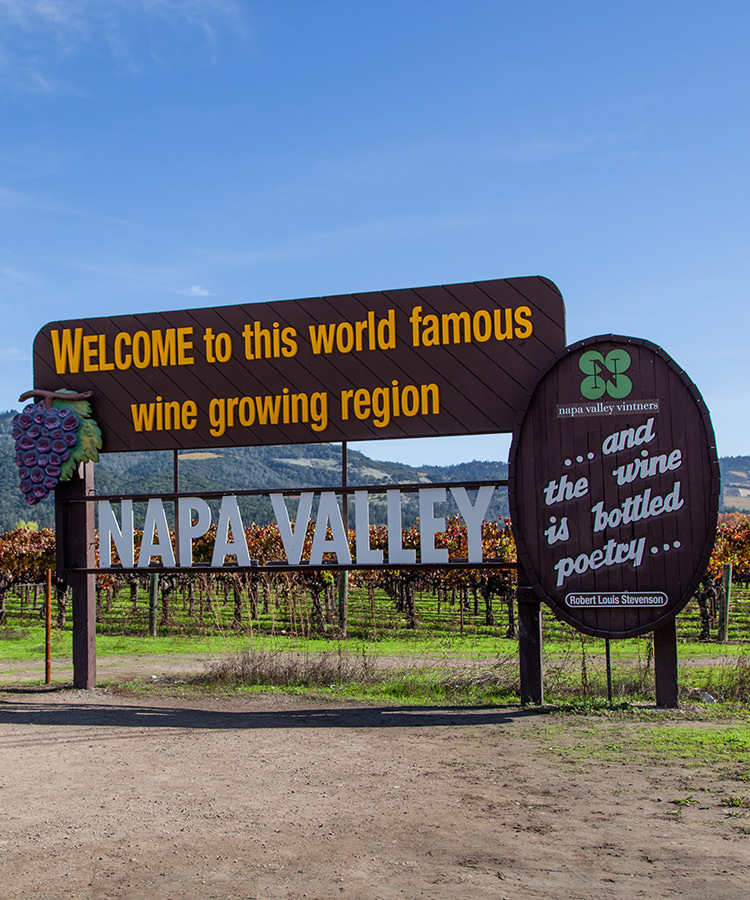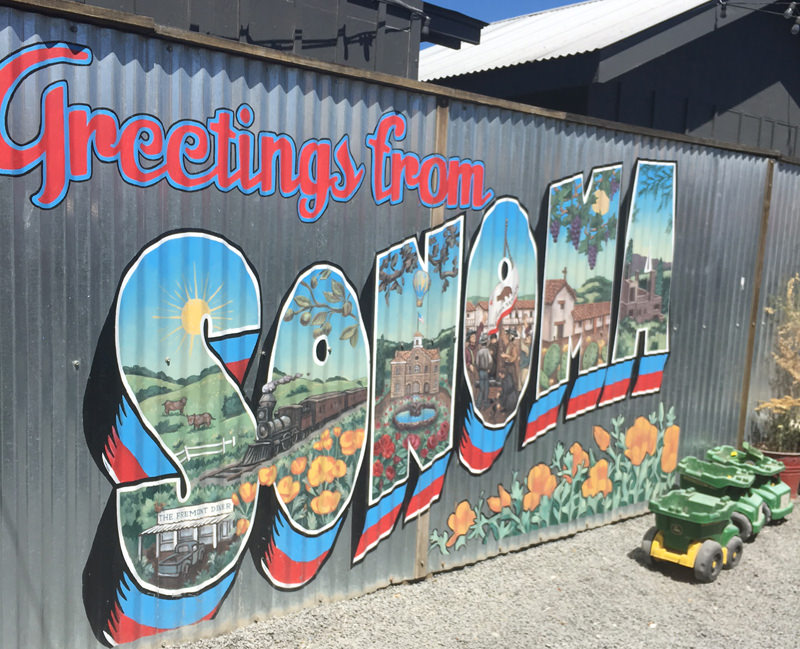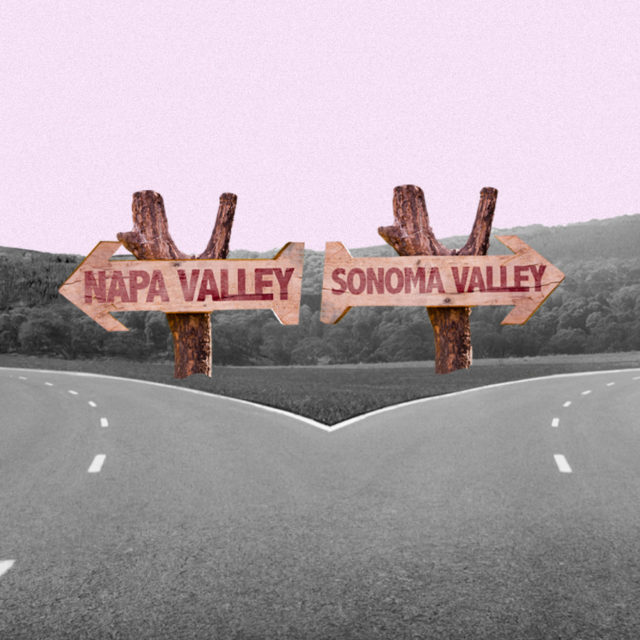There’s no question that Napa and Sonoma are two of the most beloved wine destinations in the world. What’s less certain, however, is what exactly people mean — or think they mean — when they talk about them.
Napa and Sonoma are both towns, counties, and valleys. As valleys, they are also often used interchangeably with their eponymous American Viticultural Areas (AVAs). And to make things more complicated, Napa and Sonoma’s overarching geographic areas are also home to many other wine country towns.
All of these variations — and their overlap — can be puzzling, to say the least. Consider the following a geography lesson on Northern California wine.

“People are often completely confused, and I have to explain the differences,” says Kellie Fuller, concierge for the Cottages of Napa Valley, who has worked in the wine and hospitality industry in Northern California for three decades. “And not everyone is staying at a place where there is a concierge.”
Indeed, visitors planning their own itineraries can be overwhelmed by the amount of information available online, from tourism websites to media coverage to forums on online booking sites. “On the TripAdvisor forums, I’m one of several self-appointed ambassadors to the Napa Valley,” Fuller says. “I’m always doing my best to answer questions and clear things up.”
Even Bay Area locals can get puzzled. Kelly Carter, communications director for Alpha Omega winery in Rutherford (in the heart of Napa Valley), and four-year resident of the valley, recently received an email from a friend in San Francisco. The woman was requesting recommendations for wineries or tasting tours in Yountville, a charming town in Napa County; or Healdsburg, an equally popular town in Sonoma County. But Carter paused when she read it because her friend said she “just [didn’t] want to go as far as Napa or Sonoma this time” — a head-scratching detail because both Yountville and Healdsburg are considerably farther, respectively, from San Francisco than the towns of Napa and Sonoma.
“People just don’t get it,” Carter says. “There’s Napa County, the city of Napa, and Napa Valley. People think they’re all just one big thing, and they’re not.”
Then, there’s the general confusion over geography, locals say. “People think Napa and Sonoma, as general wine regions, are five minutes apart, when in fact it can take you an hour or more” to travel between them, Carter says. She adds, “Oh, and by the way, there’s a mountain range that separates the two.”
Also, in difficult times when a fire breaks out in Northern California wine country, as is distressingly common in recent years, Fuller often receives calls from guests wondering if they should still come to the Cottages of Napa Valley, even if the fire is more than 50 miles away in Sonoma County.
The best way to make the most of any trip to the region is to do some homework ahead of time about how you want to explore it. “The experience is so important, so consider what kind you want to have,” says Jessica Boone, winemaker at Passalacqua, a popular winery in Sonoma County’s Dry Creek Valley. “Do you want to sit down for a seated tasting and have an hour or so to really get to know the wines, or do you want to hit several places that have bar tastings, where you can get more of a broad brushstroke of a place?”
To help answer those questions and clear up some confusion, we’ve put together a handy cheat sheet to explain these nuances. Think of it as a primer for planning your next trip, so that you can stop getting tripped up over county versus valley versus city — and start focusing on the fun stuff, like which winery you’ll hit first.
NAPA
Napa County
Napa County is home to nine cities and towns, from Napa itself (more on that below), to towns like Yountville, St. Helena, and Calistoga, located in the heart of the valley. Traveling from San Francisco, you’ll most likely come through the business corridor of American Canyon, which is about 10 miles south of the city of Napa. And with approximately 450 wineries with tasting rooms to choose from across the county, there is certainly something for all kinds of palates and drinkers, from the energetic newbie to the serious collector.
Napa Valley
This strip of land that runs up the middle of the county is what most people mean when they are talking about Napa’s wine-growing region. In 1981, Napa Valley became the first AVA, or American Viticultural Area, designated in California, and there are currently 16 sub-appellations within it. Napa Valley’s geographic footprint is relatively small — just 30 miles long and five miles across at its widest point, about a third of the size of the entire county — but the region produces some of the world’s most coveted wines. Varieties like Cabernet Sauvignon and Chardonnay are virtually synonymous with Napa Valley, but winemakers here also produce Pinot Noir, Merlot, Zinfandel, and Sauvignon Blanc, among others.
There are two main roads that run north-south in Napa Valley: Highway 29, the beautiful but heavily trafficked two-lane road that goes through its most prominent wine-centric towns, like Napa, Yountville, St. Helena, and then Calistoga; and the Silverado Trail, known in locals’ parlance just as “the Trail,” which runs east of Highway 29 and is flanked by such wineries as Stag’s Leap Wine Cellars and Robert Phelps. Several smaller through-ways connect Highway 29 and the Silverado Trail. Near Calistoga, at the northern end of the Silverado Trail, wine and movie buffs will delight in a stop at Chateau Montelena, which put California in the global spotlight in the 1976 Judgement of Paris (Stag’s Leap also won that day).
You’ll probably also hear residents saying “up valley” or “down valley,” and you may notice those terms in names of local businesses, too. They’re used interchangeably as both a geographic location (“I live up valley” — as in Calistoga, for example) or direction (“I’m headed down valley for an appointment this afternoon”).
The City of Napa
Over the last decade, the city of Napa has evolved from a quick stopover for thirsty visitors on their way to wineries up valley (around Yountville and Calistoga, that is), to a destination in its own right. The completion of extensive flood-control measures and a multi-million-dollar renovation along the riverfront and downtown have brought unprecedented energy and droves of travelers as of late. Tasting rooms intertwine with buzzing restaurants and boutiques, and even if you’re just passing through, a stop at the excellent Oxbow Public Market to stock up on gourmet picnic provisions is a must-do.
One especially noteworthy newer addition to the dining scene is Compline, a restaurant and wine shop founded by Master Sommelier Matt Stamp and Ryan Stetins, who oversaw the programs at Charlie Trotter in Chicago and Las Vegas. Meanwhile, a handful of snazzy new hotels, including the Andaz Napa and the Archer Hotel Napa, make downtown Napa an ideal home base for exploring Northern California wine country.
SONOMA

Sonoma County
More spread out than its Napa counterpart, Sonoma County stretches from about 30 miles north of San Francisco all the way up to the small town of Cloverdale, just off Highway 101. More than 30 cities and towns are dotted throughout its 1,768 square miles, most of which are entrenched in the wine industry, spanning about 425 wineries with tasting rooms. Healdsburg is a hub for tasting-centric getaways, while funky Guerneville, on the Russian River, is more laid back.
Go farther west, and you’ll hit the coast — in fact, many first-time visitors don’t realize that Sonoma County borders the Pacific Ocean, and its 55 miles of rugged coastline are the secret ingredient to some of its most coveted Pinot Noirs and Chardonnays.
Sonoma Valley
You won’t hear people throwing around the term Sonoma Valley, one of 18 AVAs in Sonoma County, as often as they do Napa Valley. But it has the longest history of any wine-growing region in Sonoma County, dating to the 1850s. Located in the southeast corner of the county, Sonoma Valley is best known for its robust Zinfandel, whose gnarled vines look like troll hands clawing their way from the soil. Lately, varieties like Malbec, Syrah, and Grenache are also gaining traction.
The City of Sonoma
Nestled in the heart of Sonoma Valley, the city of Sonoma itself is a delightful place to spend a day. Many of its tasting rooms are centered around the leafy town square; most welcome walk-ins, but call ahead for reservations on busy weekends. Pinot lovers shouldn’t miss stopping in Sojourn, known for its outstanding Pinot Noir. When it’s time for a bite, Girl & the Fig is a 20-year-old wine country institution that helped put farm-to-table fare on the map.
